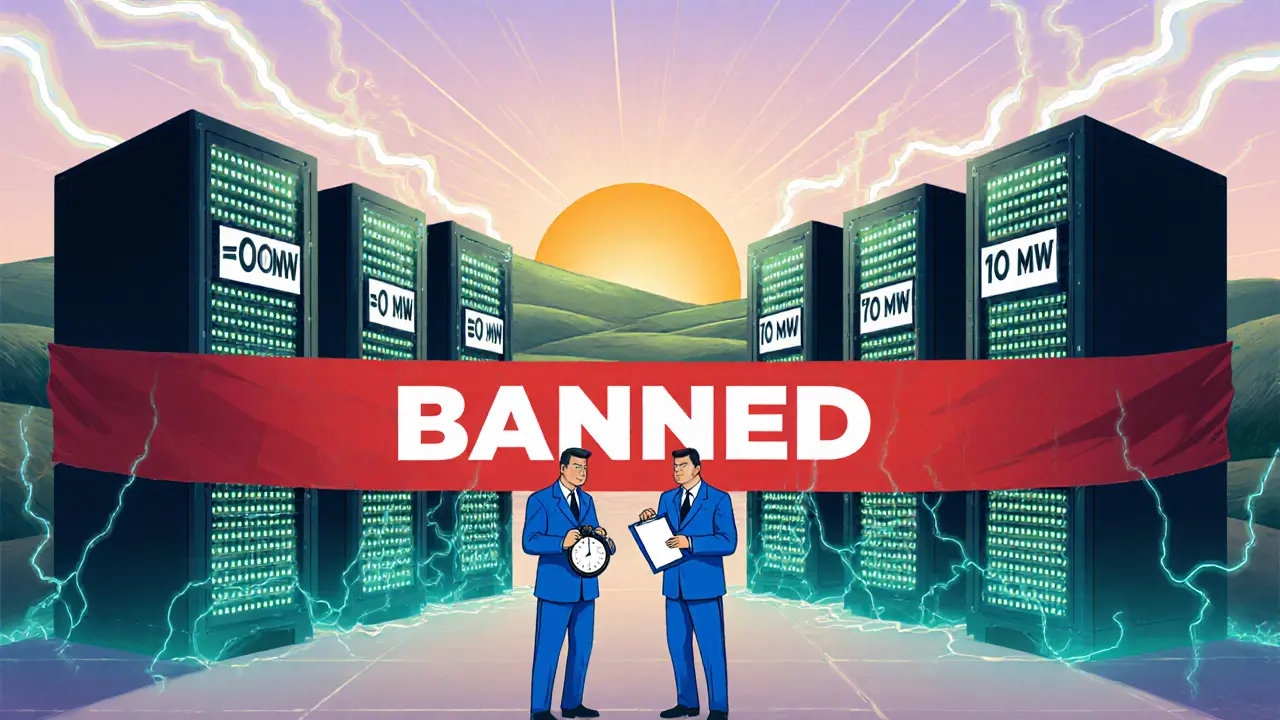Grid Impact Calculator
Mining Impact Calculator
Grid Consumption Analysis
Updated:Recommended Actions
- For Operators: Apply for KEGOC efficiency permit if consuming >10 MW
- For Investors: Consider renewable co-location projects
- For Regulators: Accelerate smart-grid deployment
When you hear that Kazakhstan is grappling with rolling blackouts and a sudden clampdown on crypto mining, you might wonder how the two are linked. The short answer: a crumbling power network and soaring electricity demand from mining farms forced the government to act. Below we break down the grid’s condition, the ban’s specifics, and what’s being done to keep the lights on.
What’s wrong with the Kazakhstan energy grid?
By early 2024 the national grid operator KEGOC reported that more than one‑third of the country’s power plants were operating at 70‑90% wear and tear. The Unified Power System (UPS) - a network of 220 active plants - can generate about 20.4 GW of usable power, but the installed capacity sits at 24.6 GW. That gap shows how much capacity is tied up in aging equipment that can’t reliably feed electricity into the system.
Technical losses - why every fifth kilowatt disappears
Regional transmission losses average 17.42% in the worst zones, far above the 10‑12% benchmark for developed markets. In the city of Oral, losses peaked at 18%, meaning one out of every five kilowatt‑hours never reaches consumers. The Ministry of Energy attributes most of this waste to outdated transformers, overloaded lines, and poor maintenance practices.
Impact on households and businesses
- Frequent voltage drops trigger appliance failures.
- Industrial users, especially those running energy‑intensive processes, face production stoppages.
- Tariffs jumped 50% by April 2025 as the single‑buyer model tried to cover rising procurement costs.
These pressures created an urgent need for the government to cut consumption wherever possible - and crypto mining became a convenient target.
The crypto mining ban - who, what, and why
In March 2025 Kazakhstan’s Ministry of Digital Development announced a temporary ban on large‑scale crypto mining operations. The order applies to farms that consume more than 10 MW of continuous power and those that do not hold a special energy‑efficiency permit from KEGOC. Violators face fines up to $200,000 per day of non‑compliance and possible confiscation of equipment.
The rationale is straightforward: mining farms were siphoning up to 15% of the nation’s marginal electricity during peak hours, aggravating already‑high losses. By restricting the most power‑hungry players, authorities hope to shave several hundred megawatts off the grid’s peak load.

Renewable energy - the long‑term solution
Renewables currently contribute just 6% of Kazakhstan’s electricity generation, but the government plans to install three 1‑GW wind farms by 2027 and double solar capacity within five years. Investment commitments total $2.6 billion, though they lag behind regional rivals like Uzbekistan.
Smart‑grid technologies are also on the agenda. Implementing advanced metering infrastructure could help detect real‑time losses and reroute power more efficiently, potentially cutting technical losses by 3‑5% points.
Infrastructure upgrades in the pipeline
KEGOC’s 2023‑2032 development plan outlines three flagship projects:
- Completion of the Western Zone integration by 2040, unifying the nation’s UPS into a single, more resilient network.
- Construction of the North‑South HVDC Line (2024‑2029), adding 2 000 MW of transmission capacity and linking Kazakhstan to the CASA‑1000 regional project.
- Deployment of smart‑grid pilots in the Almaty and East Kazakhstan regions to trial demand‑response programs.
These upgrades aim to reduce bottlenecks, improve cross‑border power flows, and create a flexible backbone capable of absorbing more solar and wind power.
Regulatory landscape - who’s in charge?
The Ministry of Energy oversees the power sector, while the Ministry of Digital Development handles crypto‑related regulations. The Eurasian Economic Union (EEU) is also pushing for a Common Electricity Market slated for launch in 2025, meaning Kazakhstan must align its grid standards with neighboring countries like Russia and Belarus.
The single‑buyer model remains a choke point; the state utility purchases all generation and sells to distributors. This structure limits price competition and makes it harder for small renewable producers to enter the market.

What does the future look like?
Analysts warn that without accelerating renewable deployment and completing the HVDC line, Kazakhstan could face electricity shortages by 2030. The ban on large crypto farms is expected to be lifted once the grid’s capacity improves, but only for operators that meet strict efficiency criteria.
In the meantime, smaller mining outfits are shifting to off‑peak hours or moving operations to countries with cheaper energy, such as Iran or Mongolia, to stay viable.
Practical checklist for stakeholders
- Investors: Prioritize projects that align with the government’s 2025‑2030 renewable targets.
- Mining operators: Apply for KEGOC’s energy‑efficiency permit and consider co‑locating with renewable farms to secure stable power.
- Policy makers: Accelerate smart‑grid rollouts and revise the single‑buyer model to enable more market competition.
Key takeaways
- The grid’s aging infrastructure causes technical losses up to 18% in some regions.
- Crypto mining bans target farms using >10 MW without efficiency certification.
- Renewable projects and HVDC line construction are central to solving the shortage.
- Regulatory reform and smart‑grid tech are needed to meet the 2030 demand forecast.
Why did Kazakhstan ban crypto mining?
The ban was introduced to curb the surge in electricity demand from large mining farms, which were worsening already‑high transmission losses and triggering blackouts during peak periods.
What size of mining operation is affected?
Any operation that continuously consumes more than 10 MW of power without a KEGOC‑issued energy‑efficiency permit is subject to the restriction.
How are transmission losses calculated?
Losses are measured as the percentage difference between electricity generated at power plants and the amount actually received by end‑users, accounting for heat, resistance, and technical faults in lines and transformers.
When will the ban be lifted?
The government has not set a firm date; lifting is tied to the rollout of new transmission capacity and the adoption of smart‑grid solutions that reduce overall demand pressure.
What renewable projects are currently under construction?
Three 1‑GW wind farms, several solar parks totaling over 2 GW, and the North‑South HVDC Line, which will link new renewable zones to the national grid.







Jenna Em
October 20, 2025 AT 08:44They say the grid is just old, but old tech is a perfect cover for the elite who thrive on chaos.
Every blackout feels like a reminder that power isn’t just electricity – it’s control.
Stephen Rees
October 23, 2025 AT 04:44The narrative of “just wear and tear” is too convenient, and the silent agreement among officials hints at something deeper.
It’s as if the lights are a bargaining chip in a game we never asked to play.
Katheline Coleman
October 26, 2025 AT 00:44In accordance with the latest KEGOC reports, approximately 30 % of generation assets operate beyond their designed service life, contributing substantially to the reported 17 % technical loss average in the most affected zones.
These figures underscore the urgency for targeted capital investment and modernization of transmission infrastructure.
Amy Kember
October 28, 2025 AT 19:44Those farms guzzling 10 MW are a drain, plain and simple.
Cut them out and you’ll see the grid breathe a little easier.
Evan Holmes
October 31, 2025 AT 15:44Fine, keep the lights on, I guess.
Isabelle Filion
November 3, 2025 AT 11:44One must applaud the sheer ingenuity of deploying a policy that simultaneously punishes economic growth and rewards opacity.
It is, without doubt, a masterclass in bureaucratic theater, where the curtain never lifts to reveal the true protagonists.
Perhaps the next act will involve subsidizing candle manufacturers as a stop‑gap solution.
Meanwhile, the climate of uncertainty grows thicker, much like the fog of misinformation that blankets the entire discourse.
Jon Miller
November 6, 2025 AT 07:44Whoa, the drama here is wild! I mean, imagine living through a blackout while the world’s biggest Bitcoin rigs are humming away.
It’s like a scene from a cyber‑punk flick, except it’s real life and the stakes are our electricity bills.
Hope the government’s plan actually works, otherwise we’ll be trading memes by candlelight.
Ryan Steck
November 9, 2025 AT 03:44Yo, these so called “reports” are a total scam-gotta love how they hide the real story behind fancy numbers.
They’re just feeding the myth that the grid’s fine while pulling the rug out from under us.
Patrick Day
November 11, 2025 AT 23:44They don’t want us to know that the real power behind the ban is a cabal of oil barons scared of losing their monopoly.
All that talk about “efficiency” is just a smokescreen.
Prerna Sahrawat
November 14, 2025 AT 19:44It is a curious phenomenon, indeed, that a nation endowed with vast steppe wind corridors chooses to shackle its own potential under the pretense of crisis management.
One must consider that the narrative of “energy scarcity” is meticulously curated, a tapestry woven from threads of geopolitical ambition and domestic power struggles.
The decision to target crypto miners, while ostensibly rational, conveniently aligns with the interests of entrenched fossil‑fuel oligarchs who fear the disruptive promise of decentralized computation.
These miners, operating at scales exceeding ten megawatts, represent not merely a load on the grid but a symbol of technological autonomy that challenges the status quo.
By imposing draconian fines and equipment confiscation, the authorities are sending an unmistakable message: compliance trumps innovation.
The timing, synchronized with the rollout of the North‑South HVDC line, suggests a calculated choreography designed to showcase governmental competence while silencing dissenting voices.
Moreover, the statistical emphasis on “technical losses” often masks the reality that many transmission inefficiencies stem from deliberate under‑investment, a form of fiscal neglect disguised as inevitable decay.
One cannot ignore the subtle yet palpable influence of neighboring powers, who view Kazakhstan’s energy assets as leverage in the broader Eurasian Economic Union arena.
Thus, the ban is less about electricity and more about consolidating geopolitical influence under the veil of domestic policy.
In the public sphere, the rhetoric of “protecting households” resonates, yet the beneficiaries of this protection are those who wield control over the nation’s mineral wealth and energy subsidies.
The swift migration of smaller mining outfits to off‑peak operations or neighboring jurisdictions underscores a market response that the ban failed to anticipate.
It also illustrates a resilience that the state’s heavy‑handed approach cannot easily extinguish.
Consequently, the grid’s chronic vulnerabilities persist, awaiting a genuine commitment to renewable integration and transparent governance.
In the final analysis, the ban serves as a case study in how technocratic measures can be co‑opted by entrenched interests to perpetuate a cycle of dependency and control.
Only a concerted, transparent effort-free from clandestine agendas-will restore sanity to Kazakhstan’s power landscape.
Erik Shear
November 17, 2025 AT 15:44I see the frustration, but maybe we can find a middle ground where miners invest in greener tech and the grid gets the upgrades it needs.
Collaboration between regulators and the crypto community could unlock funding for modernizing transformers.
At the end of the day, everyone wants reliable electricity.
Benjamin Debrick
November 20, 2025 AT 11:44It is, in fact, an incontrovertible truth that energy policy, when executed without comprehensive stakeholder analysis, invariably leads to suboptimal outcomes; consequently, the current ban, while ostensibly well‑intentioned, neglects the marginal cost curves associated with renewable integration, which, if properly calibrated, could accommodate high‑load mining operations without compromising grid stability.
Furthermore, the statistical models employed by the Ministry appear to discount the elasticity of demand inherent in decentralized computing ventures, thereby overstating the perceived threat.
This analytical oversight underscores the necessity for a multidisciplinary task force, comprising not only engineers but also economists and cryptographers, to devise a balanced framework.
Anna Kammerer
November 23, 2025 AT 07:44Sure, the “reports” are a scam-if you enjoy watching accountants juggle numbers while the lights flicker.
On a serious note, the actual loss figures are publicly available through KEGOC’s transparency portal, so anyone can verify the data themselves.
Just pull up the latest quarterly summary and you’ll see the real numbers behind the hype.
Tiffany Amspacher
November 26, 2025 AT 03:44Oh, the plot thickens! While the oil barons sip their tea, the rest of us are left wondering if the real coup d’état is happening behind the curtain of “energy policy.”
But hey, maybe the next episode will feature a heroic solar farm saving the day.
Tom Glynn
November 28, 2025 AT 23:44Wow, that was an epic deep‑dive! 🌊 It’s amazing how many layers there are to this grid saga.
Remember, change starts with awareness, and you just sparked a lot of thoughts for us all. 🙌
Johanna Hegewald
December 1, 2025 AT 19:44Check KEGOC’s site for the latest upgrade timeline; they post progress reports every quarter.
Mike GLENN
December 4, 2025 AT 15:44The idea of assembling a task force sounds ideal, yet the political will to bring together such a diverse group often falters under bureaucratic inertia.
Moreover, aligning the incentives of miners, who chase profit, with the long‑term sustainability goals of the nation is no small feat.
Nevertheless, incremental steps-like offering tax credits for farms that adopt renewable energy sources-could pave the way.
Historical precedent shows that when regulatory frameworks evolve gradually, stakeholder resistance diminishes.
Thus, a phased approach, coupled with transparent reporting, may be the pragmatic path forward.
In any case, continued dialogue remains essential.
BRIAN NDUNG'U
December 7, 2025 AT 11:44It is with great optimism that we anticipate the forthcoming infrastructure projects to herald a new era of energy security for Kazakhstan.
Let us collectively endorse these endeavors, recognizing that sustained progress derives from collaborative effort and steadfast resolve.
Donnie Bolena
December 10, 2025 AT 07:44Indeed, the future shines bright-especially with solar and wind on the horizon!; let’s keep the conversation going, celebrate each milestone, and champion innovation every step of the way.